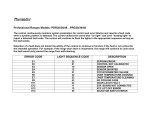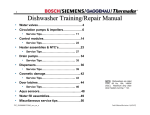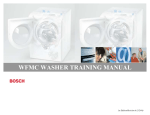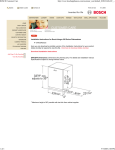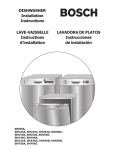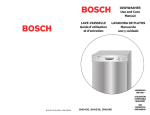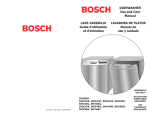Download Range Error Codes
Transcript
WFR 2460 Service Tips -- Test Program The last 8 fault codes are stored & displayed! HINT: # of errors reads “0” for faults which didn’t occur. Look at # of errors, not error #, to see if faults occurred. HINT: Scroll thru all errors to check if any occurred. B Range Error Codes CODE DESCRIPTION Oven temperature sensor failure WHEN CHECKED Cook or clean programmed When W. Drawer is active Latch should be locked Latch should be unlocked Always Latch unlocked Latch locked Always FAULT LIMIT 20 sec 20 sec 1 min 1 min 1 min 5 sec 5sec 1 min Always 1 min Always Cook or clean programmed Always 1 min 1 sec 1 sec 1 sec 1 sec F31 F33 F41 F43 F45 F111 F113 F121 Warning Drawer Sensor Failure Motorized latch will not lock Motorized latch will not unlock Motorized Latch both locked and unlocked Runaway Oven temperature 585°F Runaway Oven temperature 950°F Stuck key in the membrane switch layer F125 Cancel key circuit problem F141 F151 F153 F154 F155 Slave micro not functioning Eeprom failure or communication circuit failure User Interface too hot Power Board too hot Cook profile corrupted in EEPROM Cook or clean Programmed F170 F190 F200 F210 Power Failure Power over voltage Time out and stop function Range exceeded safe test limits Always At power on During Production test mode During Service test mode Always 2 ms 110 sec. 200°F B Range Error Codes – Additional Information CODE F1 F2 F3 DOOR LATCH ERROR ERROR DESCRIPTION WHEN CHECKED Meat probe not there or incorrect During Test / use Oven sensor not correct During Test / use Warming sensor not correct During Test / use Door latch problem During self-clean Temp. reaches 585 degrees F. Display shows “CONTACT During any cooking mode SERVICE” and beeps. The beep can be stopped with touching cancel zone, but display will stay up with program locked until main power is removed for a minimum of 5 seconds. If the temperature continues to rise (due to stuck relay) the latch will lock at 600 degrees F Note: Depending on model, program will only look for probes or sensors that it should have. B WFMC Service Tips – Test Program (2B): Module Fault Codes (Test1) Last 8 fault codes are stored & display! Test P1:ERRORS / P:01 (Viewing control module fault codes) – Start & end test P1 (WFMC6400) / (P:01) (WFMC3200) by pushing Start/Pause button. Scroll through list of fault codes by pushing Spin Selection (WFMC3200) or Menu (WFMC6400) buttons. • WFMC3200 display alternates between fault code (e.g. E:01) & when fault occurred on in last 8 washes (e.g. : C:00) – shows C:00 if fault didn’t occur. • WFMC6400 display shows fault code & when fault occurred on in last 8 washes (e.g. 0 – Er:01) WFMC32 Display WFMC64 Display Test # E:01 E:02 E:03 E:04 E:05 E:06 E:07 E:08 E:09 Er:01 Er:02 Er:03 Er:04 Er:05 Er:06 Er:07 Er:08 Er:09 washing washing washing washing P:16 ------E:12 E:13 E:14 ------E:20 E:21 E:22 E:24 Er:10 Er:11 Er:12 Er:13 Er:14 Er:15 Er:16 Er:20 Er:21 Er:22 Er:24 P:16 P:16 P:16 P:4 P:11 P:8/9/13 P:8/9/13 P:15 P:9 P:8 P:8 P:4 washing P:4 Problem Door open Door lock doesn’t unlock Door lock doesn’t lock Door control broken NTC open-circuited NTC shorted Unpexpected heating (heater on at wrong time) Heater doesn’t shut off Communication lost to motor Flow meter gives wrong values No water flow (within 6 minutes) Water supply time exceeded Drian pump time exceeded Overflow level exceeded Pressure sensor gives failure voltage level Can’t calibrate pressure sensor Spinning aborted due to unbalanced load Excessive foam Frequency synchronization failed Motor power relay failed HINT: # of faults reads “0” for faults which didn’t occur. Look at # of faults, not error #, to see if faults occurred – scroll thru all faults to check if any occurred. Possible Cause(s) Door lock not engaged Jammed lock or bad wire harness Jammed lock or bad wire harness Faulty Triac or control module Faulty NTC or bad wire harness Faulty NTC or bad wire harness Faulty heater or stuck heater relay Faulty heater or stuck heater relay Faulty wire harness Faulty flow meter or wire harness Faulty inlet valve, wire harness, hose Faulty inlet valve, wire harness, hose Faulty drain pump, wire harness, hose Faulty/blocked pump, hose, inlet valve Faulty pressure sensor, wire harness Faulty pressure sensor, wire harness Unbalanced load or faulty wire harness Wrong or too much detergent used Faulty control module Faulty control module B WFMC Service Tips – Test Program (2C): Motor Control Fault Codes (Test1) Last 16 fault codes are stored & display! Test P1:ERRORS / P:01 (Viewing motor control fault codes) – Start & end test P1 by pushing Start/Pause button. Scroll through list of (18) fault codes by pushing Spin Selection (WFMC3200) or Menu (WFMC6400) buttons. • WFMC3200 display alternates between fault code (e.g. d:01) & when fault occurred on in last 16 washes (e.g. : C:00) – shows C:00 if fault didn’t occur. • WFMC6400 display shows fault code & when fault occurred on in last 16 washes (e.g. 0 – Er:01) WFMC32 Display WFMC64 Display d:01 d:02 d:03 d:06 d:07 d:08 d:09 d:10 d:11 d:12 d:13 d:14 d:15 d:16 d:17 d:18 dr:01 dr:02 dr:03 dr:06 dr:07 dr:08 dr:09 dr:10 dr:11 dr:12 dr:13 dr:14 dr:15 dr:16 dr:17 dr:18 Test # P:04 P:04 P:04 P:04 P:04 P:04 P:04 P:04 P:04 P:04 P:04 P:04 P:04 P:04 P:04 P:04 Problem Motor control short circuit Motor control interruption Damaged motor control temperature sensor NTC relay failure Motor winding short circuited Motor speed sensor failed Voltage too high Power limiter switch off Voltage too low Motor control high current switch off Motor control high temperature switch off Motor control high temperature warning Power limiter warning Motor high temperature switch off Motor high temperature warning Peak voltage too high HINT: # of faults reads “0” for faults which didn’t occur. Look at # of faults, not error #, to see if faults occurred – scroll thru all faults to check if any occurred. Possible Cause(s) Faulty motor control. Faulty motor control. Faulty temperature sensor. NTC too hot or relay stuck closed. Motor winding short circuited. Faulty speed sensor or wire harness. Faulty motor control. Motor overloaded or binding. Faulty motor control. Motor overloaded or binding. Motor overloaded or binding. Motor overloaded or binding. Motor overloaded or binding. Motor overloaded or binding. Motor overloaded or binding. Faulty motor control. B WTMC Service Tips - - Test program (4A): Fault Codes WTMC Dryer Test Program Fault Codes Fault Code Fault Overheating due to clogged lint filter. Severe overheating due to clogged lint filter. Solution Clean lint filter (&air duct if necessary). Clean lint filter (&air duct if necessary). Notes Displays E:01 during normal use. Measures reduced air flow. Displays E:01 during normal use. Measures reduced air flow. E:13 Maxium drying time exceed E:17 NTC error (NTC R3 @ lint screen) NTC error (NTC R2 @ heater) Check heater, control module, NTC’s & Hi-limits. Usually faulty heater. Can also be overloaded dryer. Check NTC R3 & wire harness. Replace faulty part. Check NTC R2 & wire harness. Replace faulty part. Stops & displays E:03 during normal use (after maxium drying time limit of 240 minutes). Typically shorted or opened wire harness. Typically shorted or opened wire harness. E:20 EEPROM error Replace faulty control module. Dryer stops & can’t be restarted. E:21 Incorrect checksum Replace faulty control module. Dryer stops & can’t be restarted. E:22 Invalid update Replace faulty control module. Dryer stops & can’t be restarted. E:11 E:12 E:18 Effect . Dryer stops & can’t be restarted. Dryer stops & can’t be restarted. NOTE: To run fault codes tests to display fault codes: • While pushing & holding Start/Stop & Delicates button, rotate cycle selector knob to Extra Dry – Regular/Cotton. • Push Start/Stop button to start test. Push Start/Stop button to scroll through fault codes (if more than one exists). Do not rotate knob through Off to avoid exiting test program. • Rotate cycle selector knob to end test. B WTMC Service Tips - - Test program (4B): Fault Codes WTMC Dryer Test Program Fault Codes Fault Code E:23 Fault Model variant doesn’t match table Solution Replace faulty control module. E:24 Software version doesn’t match table Replace faulty control module. E:25 Damaged data table Replace faulty control module. E:26 Control error Replace faulty control module. NOTE: Fault displayed alternates with # of times fault occurred every two (2) seconds. If there’s no faults, displays will be blank. • E:xx = fault code from E11 – E39 (e.g. E:11) • C:xx = # of occurrences (e.g. C:01) NOTE: When test program is initially entered, last fault code will show. Display will be cleared once any test is started. Notes Effect Dryer stops & can’t be restarted. Dryer stops & can’t be restarted. Dryer stops & can’t be restarted. Dryer stops & can’t be restarted. B Service Tips – Fault Codes (1) DISHWASHER TEST PROGRAM ERROR CODES (on 2&3-digit digital displays): 0- No faults 1- Aqua Sensor (Sensotronic) fault 2- Heating system fault (heater, Hi-Limit, flow switch, NTC, control heater relay) 4- Water filling fault TIP: Fault codes add up for multiple faults 8- NTC (temperature sensor) fault (e.g. heating + water filling fault = 2 + 4 = 6 16- Water switch fault DISHWASHER TEST PROGRAM ERROR CODES (on 2&3-digit digital displays): FWater filling fault (underfill, overfill or water in the base) 2HLast wash cycle too long (> 99 minutes). Can be cold inlet water or heating system fault (heater, Hi-Limit, flow switch, NTC, control module heater relay). FDelay Start feature (not a fault code) DISHWASHER TEST PROGRAM ERROR CODES (on lower line of full text Apexx SH 99 displays): S3 - No faults A – Aqua Sensor (red) fault B – Aqua Sensor (green) fault E – Water switch fault (no pulses detected) F – Water filling fault G – Water switch fault (won’t stop running) H – Heating system fault (heater, Hi-Limit, flow switch, NTC, control module heater relay) K- NTC fault (short-circuited or open-circuited) Xx – Test program step count (testing done when = 00) TIP: Top line shows wash cycle & bottom line shows fault code. HINT: Dishwasher test program heat water to 150°F, so test programs will generally run > 20 minutes for incoming water temperatures ~ 120°F 00 000 00 000 HINT: Apexx heater runs during steps 05 08. Press “-“ button to skip to test 05 to measure heater amp draw. ◄ S- - 3- - - - - - - - - - - - - - - - ► Start ► In Cycle S3 0-------------- ► ◄ STEP S3 00 S3 00 HINT: Open door to select test program for fully-integrated models, then close door to run program. NOTE: Flow through heaters heat water ~ 2°F/minute. B Service Tips – Fault Codes (2) DISHWASHER TEST PROGRAM ERROR CODES (on SHX33A/43E/46A-B, SHV46C, SL84A models): ●○○ – Heating system fault (heater, Hi-Limit, flow switch, control heater relay) ○●○ – NTC (temperature sensor) fault ○●● – Water filling fault ●○○ – N/A SHV46C, SHX43E/46A-B, SL84A ●○● – N/A ●●○ – Aqua sensor (sensotronic) fault SHX33 ●●● – N/A Fault code LED’s Top Rack Power Scrub Reg. Wash Del./ Econo Power Scrub Reg. Wash Rinse & Hold Rinse & Hold TIP: Fault codes do NOT add up for multiple faults – shows highest fault code on list above (1st – heating, 2nd – NTC, 3rd – water filling, 4th – aqua sensor) DISHWASHER TEST PROGRAM ERROR CODES (on SHU43E/53E/66E models): Fa ults 0 - N o fa ults 1 - H e a te r E le me nt 2 - W a te r Filling 3 - NTC 4 - Aqua se nsor LE D Fa ult Code s READY CYCLE CLEAN NSF READY CYCLE CLEAN NSF READY CYCLE CLEAN NSF READY CYCLE CLEAN NSF READY CYCLE CLEAN NSF LED flashes LED lit LED off NOTE: Flow through heaters heat water ~ 2°F/minute. HINT: Open door to select test program for fully-integrated models, then close door to run program. HINT: Dishwasher test program heat water to 150°F, so test programs will generally run > 20 minutes for incoming water temperatures ~120°F. B Thermador BSH HOME APPLIANCES CORPORATION ERROR CODES For products with electronic controls B B Error Cause Corrective Action F31 Upper (or single) oven temperature sensor failure. An open or short circuit in the sensor wiring. 1. Check all connections, especially P4 on the Power Board. 2. Unplug the sensor connector and check sensor resistance (approximately 1080 ohms at room temperature with connector removed). Remember to reconnect it. 3. Check that neither sensor wire is open or pinched to the appliance chassis. 4. Check that the solder joints in header P4 on the Power Board are not broken. 5. If sensor is OK, replace Power Board. 29 B Error Cause Corrective Action F32 Lower oven temperature sensor failure. 1. Check all connections, especially P24 on the Power Board. 2. Unplug the sensor connector and check sensor resistance (approximately 1080 ohms at room temperature with connector removed). Remember to reconnect it. 3. Check that neither sensor wire is open or pinched to the appliance chassis. 4. Check that the solder joints in header P4 on the Power Board are not broken. 5. If sensor is OK, replace Power Board. An open or short circuit in the lower oven sensor wiring. F41 Upper (or single) oven motorized latch will not lock. Defective or jammed upper (or single) oven door or latch switches. Defective latch motor or its wiring. 1. Check P4 connector on the Power Board. 2. Ensure door latch switches are operating properly. 3. Check that neither latch switch nor common wires are pinched to the appliance chassis. 4. Check P10 connector and check if latch motor wire is pinched to the appliance chassis. 5. If F41 persists, replace Power Board. 30 B Error Cause Corrective Action F42 Lower motorized latch will not lock. 1. Check P24 connector on the Power Board. 2. Ensure door latch switches are operating properly. 3. Check that neither latch switch nor common wires are pinched to the appliance chassis. 4. Check P10 connector and check if latch motor wire is pinched to the appliance chassis. 5. If F42 persists, replace Power Board. Defective or jammed lower oven door or latch switches. Defective latch motor or its wiring. F43 Upper (or single) oven motorized latch will not unlock. Defective or jammed upper oven door or latch switches. Defective latch motor or its wiring. 1. Check P4 connector on the Power Board. 2. Ensure door latch switches are operating properly. 3. Check that neither latch switch nor common wires are pinched to the appliance chassis. 4. Check P10 connector and check if latch motor wire is pinched to the appliance chassis. 5. If F43 persists, replace Power Board. 31 B Error Cause Corrective Action F44 Lower motorized latch will not unlock. 1. Check P24 connector on the Power Board. 2. Ensure door latch switches are operating properly. 3. Check that neither latch switch nor common wires are pinched to the appliance chassis. 4. Check P10 connector and check if latch motor wire is pinched to the appliance chassis. 5. If F44 persists, replace Power Board. Defective or jammed lower oven door or latch switches. Defective latch motor or its wiring. F45 Upper (or single) oven latch both locked and unlocked. Defective or jammed upper oven door or latch switches. 1. Check P4 connector on the Power Board. 2. Ensure door latch switches are operating properly. 3. Check that neither latch switch nor common wires are pinched to the appliance chassis. 4. If F45 persists, replace Power Board. 32 B Error F46 Cause Lower oven latch both locked and unlocked. Defective or jammed lower oven door or latch switches. F111 Runaway upper (or single) oven temperature (>650°F). a) Oven powered on when temperature inside oven is >650°F. b) Intermittent or bad temperature sensor. c) Heating element relay stuck on. Corrective Action 1. Check P24 connector on the Power Board. 2. Ensure door latch switches are operating properly. 3. Check that neither latch switch nor common wires are pinched to the appliance chassis. 4. If F44 persists, replace Power Board. 1. Allow oven to cool down <650°F before turning power on. 2. Check P4 connector on the Power Board. 3. Unplug the upper (or single) oven sensor connector and check sensor resistance (approximately 1080 ohms at room temperature with connector removed). 4. If sensor is OK, replace Power Board. 5. Check wiring to heating element. If OK, replace Power Board. 33 B Error Cause F112 Runaway lower temperature (>650°F). a) Oven powered on when temperature inside oven is >650°F. b) Intermittent or bad temperature sensor. c) Heating element relay stuck on. Runaway upper (or single) oven temperature (>950°F). a) Intermittent or bad temperature sensor. b) Heating element relay stuck on. F113 Corrective Action 1. Allow oven to cool down <650°F before turning power on. 2. Check P24 connector on the Power Board. 3. Unplug the sensor connector and check lower sensor resistance (approximately 1080 ohms at room temperature with connector removed). 4. If sensor is OK, replace Power Board. 5. Check wiring to heating element. If OK, replace Power Board. 1. Check P4 connector on the Power Board. 2. Unplug the upper (or single) oven sensor connector and check sensor resistance (approximately 1080 ohms at room temperature with connector removed). If sensor is OK, replace Power Board. 3. Check wiring to heating element. If OK, replace Power Board. 34 B Error Cause F114 Runaway lower temperature (>950°F) a) Intermittent or bad temperature sensor. b) Heating element relay stuck on. 1. Check P24 connector on the Power Board. 2. Unplug the sensor connector and check lower sensor resistance (approximately 1080 ohms at room temperature with connector removed). 3. If sensor is OK, replace Power Board. 4. Check wiring to heating element. If OK, replace Power Board. F121 Stuck keyboard key. 1. Check all connections between the display head (P5) and the keyboard (J1). 2. Make sure that there are no objects in close proximity to the front and back sides of the keypads. 3. Replace Display Board or keyboard or both. Bad display head or bad keyboard. F123 Keyboard disconnected Bad connection between keyboard and Display Board. Corrective Action 1. Check all connections between keyboard (J1) and Display Board (P5). 2. If OK, replace keyboard or Display Board or both. 35 B Error Cause F125 [Upper Cancel] or [Cancel] for single oven key circuit problem. F126 F127 F141 Bad connection or bad Display or keyboard. [Lower Cancel] key circuit problem. Bad connection or bad Display or keyboard. [Cancel] key redundant return problem. Bad connection or bad Display or keyboard. Slave micro not functioning. Bad connection or bad Display or keyboard. Corrective Action 1. Check all connections between keyboard (J1) and Display Board (P5). 2. If OK, replace keyboard or Display Board or both. 1. Check all connections between keyboard (J1) and Display Board (P5). 2. If OK, replace keyboard or Display Board or both. 1. Check all connections between keyboard (J1) and Display Board (P5). 2. If OK, replace keyboard or Display Board or both. 1. Check power and Display Board connectors P1B and associated wiring. 2. If OK, replace Power Board. 3. If fault persists, replace Display Board. 36 B Error Cause F143 Vcc open circuit on slave micro. Bad Power Board or Display Board. F145 Sensor input on the slave micro shorted together. Corrective Action 1. Check power display and Display Board connectors P1B associated wiring. 2. If OK, replace Power Board. 3. If fault persists, replace Display Board. Replace Power Board. Bad Power Board. F147 Ground open circuit on the slave micro. Replace Power Board. Bad Power Board. F151 Eeprom failure or communication circuit error. Bad Power Board or Display Board. 1. Check power and Display Board connectors P1B and associated wiring. 2. If OK, replace Display Board. 3. If fault persists, replace Power Board. 37 B Error Cause Corrective Action F153 Control calibration values not in range. 1. (If possible, re-calibrate.) 2. Check power and Display Board connectors P1B and associated wiring. 4. If OK, replace Power Board. 5. If fault persists, replace Display Board. 1. If possible, re-write default data to the Display Board eeprom via P7. 2. If not, replace Display Board. F155 Bad Power Board or Display Board. Checksum match error. Wrong eeprom data on Display Board. 38 B FAULTS NOT DETECTED BY THE CONTROL Problem Possible Solutions Meat probe icon appears on the display even if the probe is not plugged in. 1. Check P2 connector on the Display Board and the wires. 2. Check the connection terminals on the socket mounted on the cavity left sidewall. They may be shorted or have a loose contact (for example, through the aluminum foil around the insulating material). Lock symbol is always displayed. 1. Check the latch and door switches and their connections. 2. Check if any shorts on P4 (for upper or single oven) or P24 (for lower oven) connector pins. 3. If everything is OK, try to replace the Power Board. Some of the keys are not working. No beeps when touched and expected action not executed. 1. Check the connection cable between the Display Board and the Keyboard. 2. If OK, replace the Keyboard. Buzzer Never beeps. Replace Display Board. 39 B Problem Possible Solutions Oven lights always off 1. 2. 3. 4. 1. Cavity fan doesn’t work or it works at one speed only. Cooling fan doesn’t work or it works at one speed only. Check P11 connector on the Display Board and the wires. Check the transformer. Check that the lamps are not burnt. If OK, replace Power Board. Check P10 connector on the Display Board and the wires. (Check also P19 terminal for single oven only). 2. For double oven only, check P2 connector on the Auxiliary Relay Board and the relay outputs. 3. If relay outputs don’t work, check also the two low voltage cables between Power and Auxiliary Board. 4. Check R2 (39 ohms) resistor in series with the fan coil. 1. Check P10 connector and P19 terminal on the single oven Power Board or P11 connector on the double oven Power Board and their connections. If Power Board output is not activated, replace the board. 2. Check R1 (78 ohms) resistor in series with the fan coil. 3. Check the circuit (latch switch) to by-pass the resistor for high speed in self-clean. 40 B Problem Possible Solutions One of the elements is not energized. 1. Check all connections between the relays on the Power Board and the elements. 2. Check the relay outputs on the Power Board. All the elements are not energized. 1. Check the common L1 red wire on the Power Board relays. 2. Check the safety thermostat connection in series with black L2 wire. 3. Check, if present, the DLB relay connections on the Auxiliary Relay Board. 4. Check, if present, the DLB relay outputs. If they are not OK, replace the Auxiliary Relay Board. Display never turns on 1. Check Power supply connection on the Power Board (P18 for double oven, P5 for single oven). 2. Check the P1A cable between Power and Display Board. 3. Disconnected the P1A cable and measure by a meter the voltages on the P1A connector on the Power Board. a. If they meet the values indicated in the electric schematics then replace the Display Board. b. If they don’t meet, replace the Power Board. 41 B WFR 2460 Washer Fault Codes The last 8 fault codes are stored & displayed! T1: Error (error displays). The programme can be ended with the “Start / Pause” button. The errors can be selected with the “Menu” button. Only the errors of the last 8 wash programmes are stored and displayed. Sequence: Time/Operation Display Note HINTS: # of errors reads “0” for faults which didn’t occur. Look at # of errors, not error #, to see if faults occurred. Display Er: 01 Er: 02 >>MENU T1: ERRORS 7- Er : 12 The error frequency is displayed on the lower line and the error number on the right. Error # After 105 min. Er: 09 Uncontrolled motor acceleration Motor does not rotate Motor triac defective Er: 10 Er: 11 Er: 16 Reversing relay test not passed Flow rate sensor detects low water level Water inlet time exceeded Water inlet time exceeded Pumping time exceeded Safety level reached Er: 17 Pressure sensor Er: 18 Er: 19 Er: 20 Calibration of pressure sensor not possible Aqua stop fault Turbidity sensor Er: 21 Er: 22 Update Spin cycle terminated Er: 23 Foam detected Er: 12 Hint: Scroll thru all errors to check if any occurred. Possible Cause Remedial action Door switch not actuated Close door, check lock Er: 05 Door open Door lock cannot be released Door lock cannot be locked Door actuation defective NTC interruption Er: 06 NTC short-circuit Er: 07 Unexpected heating Er: 04 Heating time exceeded Er: 13 Number of errors Error Er: 03 Er: 08 Triac defective / relay stuck Cable break / NTC damaged Cable short-circuit / NTC damaged Temperature increase without actuation of heater Er: 14 Er: 15 Replace controller Rectify cable short – circuit / replace NTC Rectify cable shortcircuit / replace NTC Start T/P 18 heater test programme 42 No / incorrect tachogenerator signal Sensor / line Water inlet / sensor W controller after 6 min. 0 level not reached within 6 min. Aqua stop actuated Calibration not possible After 15 start-up attempts Via analogue sensor Start T/P18 heater test programme Start T/P4 motor test programme. Start T/P4 motor test programme. Start T/P4 motor test programme. Check line Replace sensor Start T/P11 sensor test programme Start T/P9 controller test programme Check pump circuit Start T/P8 and 9 level test programme Check line Replace sensor Start T/P8 level test programme Eliminate leaks Start T/P10 sensor test programme Start T/P4 motor test programme Consult customer about dosing B WFK 2401 Washer Fault Codes Fault Code 00 01 02 03 04 Faults No Faults No Water filling No heating No draining Overheating Possible Causes/Notes • • Corrective Actions Water supply turned off. Water inlet hose filters (strainers) blocked. • Water pressure too low. • Control module has failed. • Water inlet valve(s) has failed. NOTE: Fault code occurs during customer use or test program. • Heater has failed. • NTC has failed. • Heater is covered with scale. • Voltage too low. • Control module has failed. NOTE: Fault code occurs during customer use or test program. • • • • • Drain pump or motor protector has failed. • Control module has failed. NOTE: Fault code occurs during customer use or test program. • Control module has failed. • NTC failed. NOTE: Fault code occurs during customer use or test program. • • • • • • • • • • 43 Turn on supply. Check water inlet hose filters. Clean if dirty. Replace if damaged. Check if incoming water pressure is 14.5 – 145 psi. Check voltage output to water inlet valves (when they’re energized). If no voltage, replace faulty control module. Measure resistance of water inlet valves (~ 2.7 – 3.3 kΩ). Replace inlet valve(s), if fault. Disconnect heater and measure resistance at terminals (~15 - 28Ω). Replace heater if faulty. Disconnect NTC and measure resistance at terminals (~5.4 – 6.5 kΩ @ 20°C (68°F)). Replace NTC if faulty. If possible, remove & clean heater. If not, replace it. Have an electrician check the house wiring and the wiring to the washer to make sure it is 240 volts. Check voltage output to heater (when it’s energized). If no voltage, replace faulty control module. Disconnect drain pump and measure resistance at connector (~ 83Ω). Replace drain pump if faulty. Check voltage output to drain pump when it’s energized). If no voltage, replace faulty control module. Check voltage to heater. If voltage is present when heater shouldn’t be on, replace faulty control module. Disconnect NTC and measure resistance at terminals (~5.4 – 6.5 kΩ @ 20°C (68°F)). Replace NTC if faulty. B WFK 2401 Washer Fault Codes Fault Code 05 06 08 Faults Possible Causes/Notes Drum motor erratic • Motor drive circuit (Triac) has failed. • Drum drive motor has failed. • Reserving relays have failed. NOTE: Fault code occurs during test program. • • • • • Door open or won’t lock Drum motor won’t run Door isn’t closed properly. Door latch is broken. Door lock is faulty. NOTE: Fault code occurs during customer use or test program. • Drum rear bearing has failed. • Motor drive circuit (Triac) has failed. • Drum drive motor has failed. • Reserving relays have failed. NOTE: Fault code occurs during test program. Corrective Actions • • • • • • • • 44 Check voltage at motor connectors when motor is energized. If low or no voltage, replace faulty control module. Check voltage at motor connectors when motor is energized. If ~240V, replace faulty drum motor. Check voltage at motor connectors when motor is energized. If voltage doesn’t reverse, replace faulty control module. Close door securely. If door won’t latch, check door latch and door hinge alignment. Replace broken door latch. Measure resistance of door lock mechanism (~ 300 – 1350 Ω). Replace faulty door lock mechanism. Check how drum rotates. If drum wobbles or won’t move, replace faulty rear bearing. Check voltage at motor connectors when motor is energized. If low or no voltage, replace faulty control module. Check voltage at motor connectors when motor is energized. If ~ 240V, replace faulty drum motor. Check voltage at motor connectors when motor is energized. If voltage doesn’t reverse, replace faulty control module. B WFK 2401 Washer Fault Codes Fault Code 09 Faults Possible Causes/Notes NTC failed • 10 NTC failed 12 Drum motor reversing relays failed Corrective Actions • Disconnect NTC and measure resistance at terminals (~5.4 – 6.5 kΩ @ 20°C (68°F)). Replace NTC if faulty. NOTE: Fault code occurs during test program. • NTC shorted • Disconnect NTC and measure resistance at terminals (~5.4 – 6.5 kΩ @ 20°C (68°F)). Replace NTC if faulty. NOTE: Fault code occurs during test program. • Reversing relays have failed. • Check voltage at motor connectors when motor is energized. If voltage doesn’t reverse, replace faulty control module. NTC open circuited. NOTE: Fault code occurs during test program. NOTES: While running water inlet valves, pressure switch, heater & drain pump test, display shows fault codes 01 since water doesn’t totally fill & 02 since water isn’t heated. This is normal. 45 B WFL 2060 Washer Fault Codes Fault Possible Causes Door open or won’t lock Door left open. Faulty door latch or door lock No water filling Water shut off. Inlet strainer filters blocked. Water pressure too low (<1 bar) Fault heater. Voltage too low. Excessive scale on heating element. Blocked sensor. Faulty water level controlled. Faulty or blocked drain pump. Faulty speed control. Triac short-circuited. Faulty reversing relay. Faulty control module. No heating No draining Motor won’t run Overheating NTC failed (short or open circuited) Flashing Lights ○ ○ ● ○ ● ○ ○ ● ● ● ○ ○ ○ ● ○ ● ● ○ ● ● ● Faulty wire harness. Faulty NTC. 46 Door locked Rinse/Spin Wash Door locked Rinse/Spin Wash Door locked Rinse/Spin Wash Door locked Rinse/Spin Wash Door locked Rinse/Spin Wash Door locked Rinse/Spin Wash Door locked Rinse/Spin Wash Program fault Occurred Wash Wash Test Wash Test Test Test B WTA 35 & WTL 54 Fault Codes & Troubleshooting HINT: Use dryer test program to diagnose dryer problems. HINT: Remove top panel of dryer to access wiring, control module and drum conductance brushes. Fault code Problem Possible Cause Damp Dry Light flashes NTC # R3 failed NTC (temperature sensor) failed. NOTE: When viewing wiring diagram, see NTC # R3. Regular Dry Light flashes NTC # R2 failed Heater (dryer overheated) Check voltage at and wiring to NTC. Turn off dryer, measure NTC resistance and replace faulty NTC. NOTE: NTC resistances: NTC (temperature sensor) failed. NOTE: When viewing wiring diagram, see NTC # R2. Extra Dry Light flashes Suggested Action 9 – 11 kΩ @ 59°F - 221°F Check voltage at and wiring to NTC. Turn off dryer, measure NTC resistance and replace faulty NTC. NOTE: NTC resistances: Heater failed. 18 – 22 kΩ @ 59°F – 392°F Check voltage at and wiring to heater. Turn off dryer, measure heater resistance and replace faulty heater. NOTE: Heater resistances: 62 – 67 Ω (800W – E2 on wiring diagram on page E-2) 25 – 29 Ω (1900W – E3 on wiring diagram) Drum motor failed. Check voltage at and wiring to drum motor. Turn off dryer, measure motor resistance and replace faulty motor. NOTE: Drum motor resistances (see wiring diagram): 19 – 25 Ω (between points X2.2 – X2.3 for WTL 54) 18 – 23 Ω (between points X2.2 – X2.4 for WTL 54) 25 – 29 Ω (between points X2.2 – X2.3 for WTL 35) 25 – 30 Ω (between points X2.2 – X2.4 for WTL 35) 47 B WTA 35 & WTL 54 Fault Codes & Troubleshooting Anti – Crease/End Light flashes Time fault (drying time too long) Control module failed. Check voltage at and wiring to module. Turn off dryer, and replace faulty module. Door lock failed. Check voltage at and wiring to door lock. Turn off dryer, measure door lock resistance and replace faulty door lock. Moisture sensor(s) failed. Run moisture sensor conductance test. Check voltage at and wiring to sensors. Turn off dryer and replace faulty sensor(s). Water level switch failed (WTL 5400 only). Check voltage at and wiring to Hi-Limit. Turn off dryer, measure Hi-Limit resistance and replace faulty Hi-Limit. Hi-Limit (“overheat”) thermostat tripped and failed to reset. Check voltage at and wiring to Hi-Limit. Turn off dryer, measure Hi-Limit resistance and replace faulty Hi-Limit. NOTE: Hi-Limit trips @ 248°F (WTL 54) or 212°F (WTA 35) Supply voltage too low. E1 --- Pump failed (WTL 5400 condensation dryer only) Dryer won’t run or indicator lights won’t come on (no power to dryer) Pump failed. Dryer not turned on. No power to dryer Dryer fuse has blown. 48 Have customer upgrade power system to provide consistent voltage to dryer during heating (need min. 198V). Check voltage at and wiring to pump. Turn off dryer, measure pump resistance (110 – 136 Ω) and replace faulty pump. Turn “on/off” switch on. Check customer circuit breaker, fuse box or power connections. Unscrew holder cap & replace fuse (15A, type SC-15). B B Dishwasher Error codes Error codes that the consumer will see on models with numeric display: F Indicates a water level or filing error. Underfill, overfill or water in the base. See note 1 2H Indicates that the last wash cycle took over 99 minutes to complete. Usually indicates inlet water too cold, or heating fault in the dishwasher. See note 1 & 2 Error codes only displayed in diagnostic program: See note 3 Models with numeric display: 0 No faults 1 Aqua Sensor “Sensotronic” fault 2 Heating fault 4 Filling fault 8 NTC (temperature sensor) fault Models without numeric display: LED’s on the buttons will be lit to indicate faults. Please refer to B/S/H Dishwasher Troubleshooting Tips or Major Appliances Technical Manual for specific model / code information. 49 B B Dishwasher Error Codes…continued NOTE 1 Once cause of this fault has been corrected, the code will reset itself 15 minutes after The dishwasher has been turned on, or by running the dishwasher through the diagnostic program. See B/S/H Dishwasher Troubleshooting Tips, or Major Appliances Technical Manual for instruction by model number. Note 2 Heating faults must be tested in the diagnostic mode. The diagnostic program will begin with running the drain motor for 30 seconds, then it will check the aqua sensor (if equipped) for 65 seconds, filling until water level switch is closed, and then the circulation pump and heater will be activated. To test heater circuit, put amprobe around the red wire from control board to the base. It would read approximately 10 amps if all is working properly. If no amperage is indicated , test for voltage (120VAC) at the red wire. If voltage is present, but no amperage, the heater assembly is at fault. If no voltage is present, the relay contact on the control board is most likely the cause. Resolder the connection as per instructions in B/S/H service bulletin. Note 3 Each model dishwasher has a diagnostic program which allows the technician to quickly diagnose specific faults without having to wait for a regular wash cycle to reach the proper time for specific events to occur. Each program will begin by running the drain motor for 30 seconds, calibrating the aqua sensor for 65 seconds (if model is equipped with aqua sensor), filing until water level switch (f1) is closed, the cir culation motor begins to run, the soap dispenser actuates, and the heater will be activated to heat the water to 150 degrees, and the unit will drain. The instruction for entering the diagnostic programs and specific fault code indication are listed in the B/S/H Dishwasher Troubleshooting Tips manual or the Major Appliance Technical Manual. Note 4 If multiple faults occur, the numeric codes will be added and displayed as a total, for example, if the unit had both a heating and an aqua sensor fault, the numeric indication would be 5, 1 for aqua sensor fault plus 4 for the heating fault. 50 B 51


































